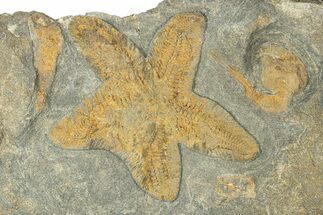This Specimen has been sold.
.85" Ordovician Carpoid Fossil - Ktaoua Formation, Morocco
This is an Ordovician-aged carpoid fossil collected from the Ktaoua Formation of Morocco. It measures .85" long and is located near the edge of a 3.75 x 2.85" section of rock. The orange coloration is due to the oxidization of iron pyrite.
Comes with an acrylic display stand.
Comes with an acrylic display stand.
Carpoids are enigmatic organisms. They are early echinoderms related to starfish and sea urchins. Unlike modern echinoderms, carpoids lack the five fold radial symmetry and water vascular system. Most were asymmetrical or bilaterally symmetrical. But like other echinoderms, they did possess a skeleton of calcite plates. Depending on the species, carpoids had one or two ambulacra (filtering appendages), a theca (“head”) and a three-section stele (“tail”). They are likely early ancestors of starfish and other echinoderms, but they may also be an early ancestor of Chordates, the phylum that humans belong to. This is a contentious theory, based on the presence or absence of early gills in carpoids. Because these organisms are only known from fossils, gills are hard to identify accurately.
Carpoids evolved during the Middle Cambrian Period and disappeared from the fossil record during the early Devonian Period.
Carpoids were unconventional-looking organisms. Their vital organs were contained in a theca, and internal organs were surrounded by calcite plates. Depending on the species of carpoid, one or two ambulacrum extended from one end of the theca. These were appendages for filtering water for food. A mouth was located at the base of the ambulacrum if there was just one, or between them if there were two. From the other end of the theca, the three section stele (“tail”) extended. This was used either for locomotion or to hold the organism in place if fixed in one location. Carpoids grew up to about 4 inches (10cm).
Carpoids evolved during the Middle Cambrian Period and disappeared from the fossil record during the early Devonian Period.
Carpoids were unconventional-looking organisms. Their vital organs were contained in a theca, and internal organs were surrounded by calcite plates. Depending on the species of carpoid, one or two ambulacrum extended from one end of the theca. These were appendages for filtering water for food. A mouth was located at the base of the ambulacrum if there was just one, or between them if there were two. From the other end of the theca, the three section stele (“tail”) extended. This was used either for locomotion or to hold the organism in place if fixed in one location. Carpoids grew up to about 4 inches (10cm).
SPECIES
Unidentified
AGE
LOCATION
Kaid Rami - Tafilalt, Morocco
FORMATION
Ktaoua Formation
SIZE
Carpoid: .85", Rock: 3.75 x 2.85"
CATEGORY
SUB CATEGORY
ITEM
#289387
We guarantee the authenticity of all of our specimens.
 Reviews
Reviews











